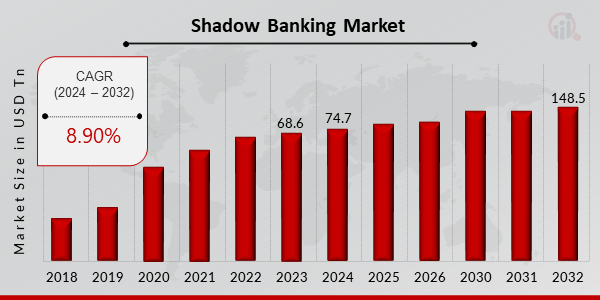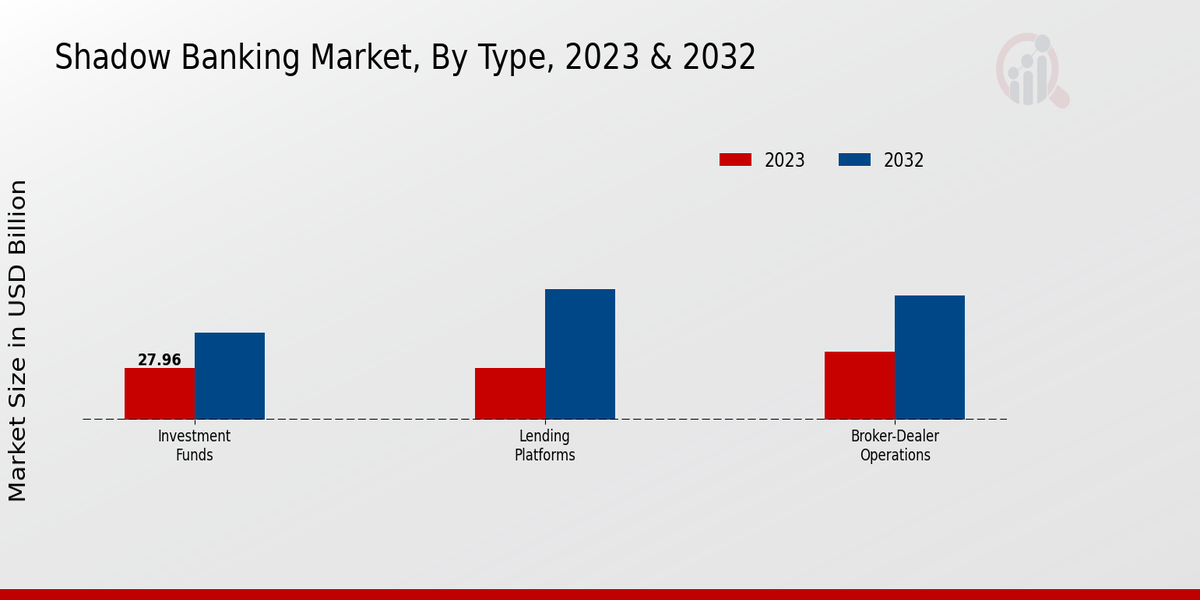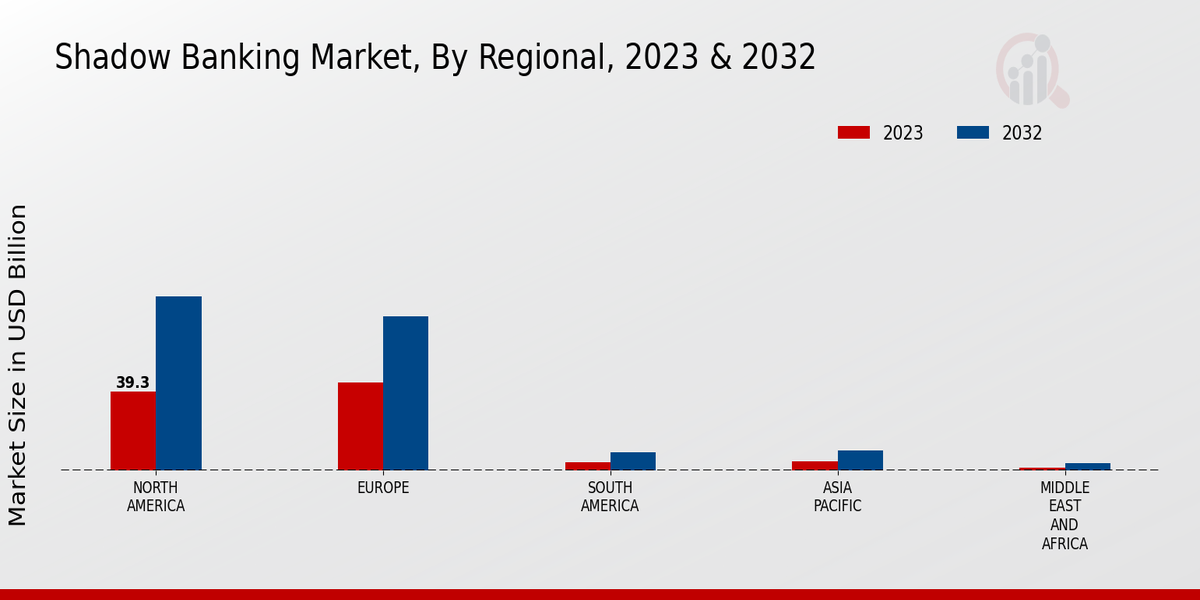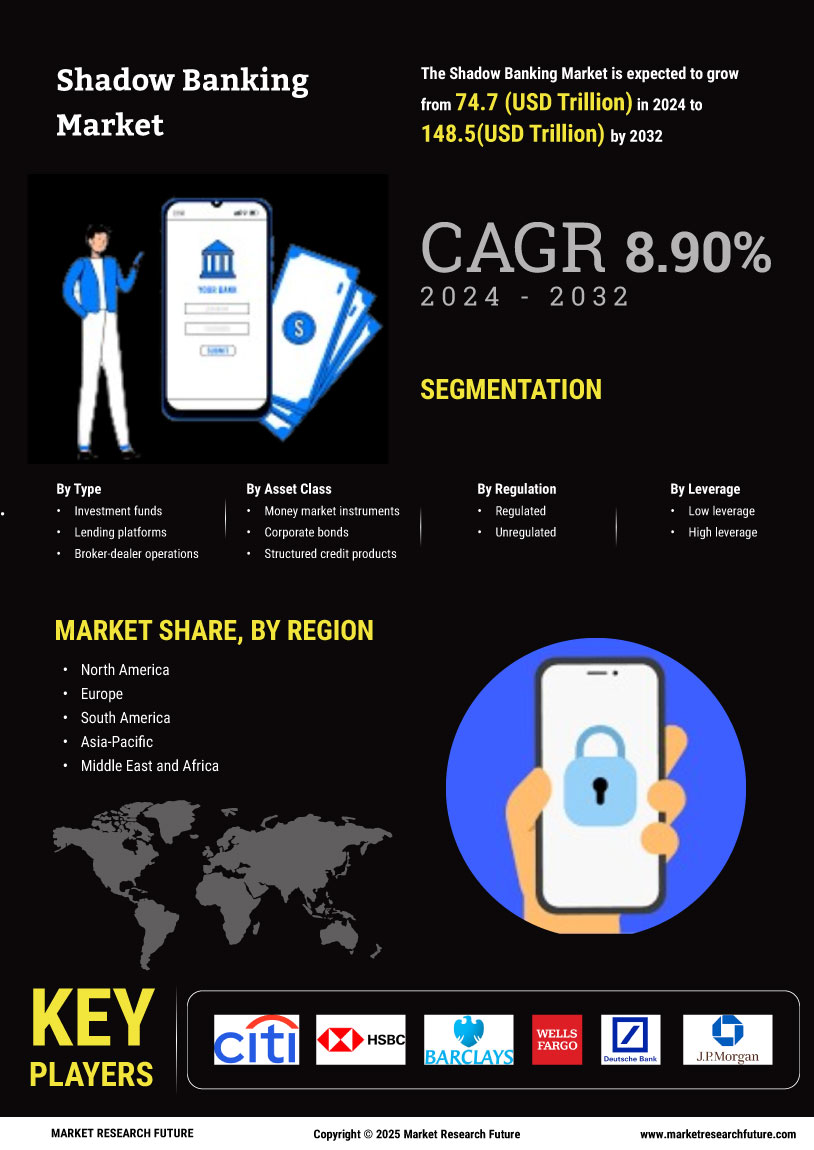Global Shadow Banking Market Overview:
The Shadow Banking Market Size was estimated at 68.6 (USD Trillion) in 2023. The Shadow Banking Market is expected to grow from 74.7 (USD Trillion) in 2024 to 148.5(USD Trillion) by 2032. The Shadow Banking Market CAGR (growth rate) is expected to be around 8.90% during the forecast period (2024 - 2032)
Key Shadow Banking Market Trends Highlighted
Increased desire for alternative financing choices, changes in regulations affecting traditional banking, and the emergence of fintech and digital platforms are some of the major market factors driving the expansion of the shadow banking market.
The creation of new financial services and products, the use of blockchain technology, and the emergence of shadow banking operations in developing nations present growth prospects.
The Shadow Banking Market is showing recent patterns that point to a move toward increased regulation and transparency as well as a stronger emphasis on risk management. Artificial intelligence and machine learning are also becoming more and more integrated into shadow banking processes, increasing productivity and lowering risk.
It is imperative to resolve issues like regulatory ambiguity, systemic dangers, and potential conflicts of interest if we are to fully realize the promise of the shadow banking market. Through embracing innovation, promoting cooperation, and guaranteeing strong regulatory frameworks, the industry may fully realize its potential to offer substitute funding sources and make a positive impact on the larger financial scene.

Source: Primary Research, Secondary Research, MRFR Database and Analyst Review
Shadow Banking Market Drivers
Increased Demand for Alternative Financing Options
One of the major drivers of growth in the Shadow Banking Market is the rising demand for alternative financing options. Traditional banks have strict requirements when it comes to lending, and many borrowers may not be able to meet these requirements.
In contrast, shadow banks are less regulated than traditional banks and can provide more flexible and creative forms of financing. This makes shadow banks an attractive option to business and personal borrowers who might not be able to access bank loans.
The demand for alternative financing options is projected to keep growing in the forecast period, and as a result, drive the growth in the Shadow Banking Market.
Growing Sophistication of Investors
The growing sophistication of investors is another key driver of growth in the Shadow Banking Market. Investors are becoming increasingly aware of the risks and rewards associated with shadow banking products.
This has led to a demand for more sophisticated and transparent shadow banking products. Shadow banks are responding to this demand by developing new products and services that meet the needs of sophisticated investors.
The growing sophistication of investors is expected to continue to drive growth in the Shadow Banking Market over the forecast period.
Regulatory Changes
Regulatory changes should also be mentioned when speaking about the increase of the Shadow Banking Market. Within the last decade, regulators have become more focused on the risk related to shadow banking.
The outcome of this situation is the introduction of regulators that “are explicitly designed to reduce shadow banking risks”. These regulation changes are expected to affect the development of the Shadow Banking Market to a great extent.
The necessity to operate in compliance with new regulations creates new opportunities for shadow banks. Such companies should either adapt to the new requirements or give up their business. Therefore, it is possible to predict that it is the companies that can operate in compliance with the new regulations that will have the greatest chances for success.
Shadow Banking Market Segment Insights:
Shadow Banking Market Type Insights
The Shadow Banking Market is divided by Type into Investment funds, Lending platforms, and Broker-dealer operations. The former is expected to claim around 45% of the total market share by 2026. The rise of this segment can be attributed to the increasing trust of institutional investors toward various alternative vehicles such as hedge funds or private equity funds.
Despite often being riskier than traditional investment instruments, such funds provide an opportunity to earn a significant return, which is crucial in the context of constantly decreasing yields on shares and bonds.
In addition, such instruments are being gradually democrticized and are now available to the wider public without strict accredited investors-only policy. The second segment, Lending platforms, is expected to register the fastest growth.
This can be explained by the increased popularity of P2P lending or other non-banking forms of credit supply, which provide lower interest rates for borrowers. This is combined with the opportunities for lenders to mitigate certain risks and offset the lower interest rates provided by the banks, with the total interest earned for the more reliable borrowers positioned at 6-7%.
At the same time, Broker-dealer operations are also expected to take up a significant share of the overall market, as they are crucial to the operation of capital markets and may only grow more important in the future.

Source: Primary Research, Secondary Research, MRFR Database and Analyst Review
Shadow Banking Market Asset Class Insights
The Shadow Banking Market is segmented by Asset Class into Money market instruments, corporate bonds, Structured credit products, and Private equity.
Among these, the Money market instruments segment held the largest market share in 2023 and is projected to continue its dominance throughout the forecast period. The growth of this segment can be attributed to the increasing demand for short-term financing options by businesses and individuals.
The Corporate bonds segment is also expected to witness significant growth during the forecast period, owing to the increasing issuance of corporate bonds by companies to raise capital.
Structured credit products and Private equity segments are also expected to contribute to the overall growth of the Shadow Banking Market, although their market share is relatively smaller compared to Money market instruments and corporate bonds.
Shadow Banking Market Regulation Insights
The Shadow Banking Market is segmented based on Regulation into Regulated and Unregulated. The Regulated segment accounted for a larger share of the market in 2023 and is projected to continue its dominance throughout the forecast period.
This is primarily due to the increasing regulatory oversight and enforcement actions taken by governments worldwide to mitigate systemic risks associated with shadow banking activities. The Unregulated segment is expected to witness a significant growth rate during the forecast period.
This growth can be attributed to the rising popularity of alternative lending platforms and the increasing demand for financing from unbanked and underbanked populations.
However, the growth of the Unregulated segment is likely to be constrained by regulatory concerns and the potential for increased financial instability.
Overall, the Shadow Banking Market is expected to witness significant growth over the forecast period, driven by factors such as the increasing demand for alternative financing options, the growing complexity of financial markets, and the regulatory initiatives aimed at mitigating systemic risks.
Shadow Banking Market Leverage Insights
The Shadow Banking Market is segmented by Leverage into Low leverage and High leverage. The Low leverage segment is expected to account for a larger market share in 2023, owing to increasing regulatory scrutiny on highly leveraged institutions.
The High leverage segment is also expected to witness significant growth over the forecast period, driven by the search for yield by investors and the increasing use of derivatives and other complex financial instruments.
Overall, the Shadow Banking Market is expected to register a CAGR of 8.0% from 2024 to 2032, reaching a valuation of 185.0 billion USD by 2032.
Shadow Banking Market Regional Insights
The Shadow Banking Market is segmented into North America, Europe, APAC, South America, and MEA.
North America is expected to hold the largest market share due to the presence of well-established financial institutions and many high-net-worth individuals.
Europe is another significant market for shadow banking, with a well-developed regulatory framework and a large pool of institutional investors.
APAC is expected to witness the fastest growth over the forecast period due to the increasing demand for alternative financing options and the growing middle class.
South America and MEA are relatively smaller markets for shadow banking, but they are expected to grow at a steady pace in the coming years.

Source: Primary Research, Secondary Research, MRFR Database and Analyst Review
Shadow Banking Market Key Players and Competitive Insights:
Major players in the Shadow Banking Market employ advanced technologies and strategies for sustained growth in the market. These players focus on innovation, strategic partnerships, targeted acquisitions, and global expansion to stay competitive.
The Shadow Banking Market includes prominent players like JPMorgan Chase & Co., Goldman Sachs Group Inc., Bank of America Corporation, Citigroup Inc., Morgan Stanley, and Deutsche Bank AG.
JPMorgan Chase & Co. (JPMC), a leading investment bank and financial services provider, plays a significant role in the Shadow Banking Market. The company offers various investment banking services, including mergers and acquisitions, capital markets, and fixed-income trading.
JPMC's strengths include its global presence, diverse product portfolio, and solid balance sheet. The company has a wide network of offices and operations in multiple countries, which allows it to cater to a broad range of clients across the globe.
Another key competitor in the Shadow Banking Market is Goldman Sachs Group Inc. (GS). GS specializes in investment banking, securities trading, and asset management. The company is known for its expertise in mergers and acquisitions, equity and debt underwriting, and proprietary trading.
GS has a strong reputation for innovation and has been involved in some of the largest and most complex financial transactions in the world. The company's commitment to research and development, coupled with its deep industry knowledge, gives it an edge in the competitive Shadow Banking Market landscape.
Key Companies in the Shadow Banking Market Include:
-
ING Group
-
Citigroup
-
HSBC
-
Barclays
-
Wells Fargo
-
Deutsche Bank
-
JPMorgan Chase
-
UBS
-
Nomura
-
Morgan Stanley
-
Credit Suisse
-
Royal Bank of Canada
-
Goldman Sachs
-
Bank of America
Shadow Banking Market Developments
Rising demand for alternative financing options, increasing regulatory scrutiny of traditional banking institutions, and growing adoption of fintech solutions are driving market growth.
Key recent developments include the launch of new shadow banking products and services, such as peer-to-peer lending platforms and crowdfunding portals, as well as the emergence of new regulatory frameworks aimed at mitigating risks associated with shadow banking activities.
The market is expected to witness significant growth in emerging economies, particularly in the Asia-Pacific region, due to increasing financial inclusion and the development of local shadow banking ecosystems.
Shadow Banking Market Segmentation Insights
Shadow Banking Market Type Outlook
- Investment funds
- Lending platforms
- Broker-dealer operations
Shadow Banking Market Asset Class Outlook
- Money market instruments
- Corporate bonds
- Structured credit products
- Private Equity
Shadow Banking Market Regulation Outlook
Shadow Banking Market Leverage Outlook
- Low leverage
- High leverage
Shadow Banking Market Regional Outlook
- North America
- Europe
- South America
- Asia-Pacific
- Middle East and Africa
| Report Attribute/Metric |
Details |
| Market Size 2023 |
68.6 (USD Trillion) |
| Market Size 2024 |
74.7 (USD Trillion) |
| Market Size 2032 |
148.5 (USD Trillion) |
| Compound Annual Growth Rate (CAGR) |
8.90% (2024 - 2032) |
| Report Coverage |
Revenue Forecast, Competitive Landscape, Growth Factors, and Trends |
| Base Year |
2023 |
| Market Forecast Period |
2024 - 2032 |
| Historical Data |
2019 - 2023 |
| Market Forecast Units |
USD Trillion |
| Key Companies Profiled |
ING Group, Citigroup, HSBC, Barclays, Wells Fargo, Deutsche Bank, JPMorgan Chase, UBS, Nomura, Morgan Stanley, Credit Suisse, Royal Bank of Canada, Goldman Sachs, Bank of America |
| Segments Covered |
Type, Asset Class, Regulation, Leverage, Regional |
| Key Market Opportunities |
Digital lending adoption Alternative investment products Growing demand for nonbank financial services Cryptocurrency adoption Regulatory arbitrage |
| Key Market Dynamics |
Credit disintermediation Regulatory arbitrage Technological advancements Rising demand for alternative financing Increasing cross-border activities |
| Countries Covered |
North America, Europe, APAC, South America, MEA |
Frequently Asked Questions (FAQ) :
The shadow banking market is expected to reach USD 148.5 Trillion by 2032, exhibiting a CAGR of 8.90% during the forecast period. In 2023, the market is valued at USD 68.6 Trillion.
North America and Europe are the dominant regions in the shadow banking market, accounting for a significant share of the global market. Asia-Pacific is anticipated to witness the fastest growth rate during the forecast period due to the increasing demand for alternative financing options and the growing number of fintech companies.
Shadow banking plays a crucial role in providing credit and liquidity to various sectors of the economy. It includes activities such as securitization, repurchase agreements, and lending by non-bank financial institutions. These activities facilitate capital formation, enhance market liquidity, and provide alternative financing channels for businesses and individuals.
Prominent players in the shadow banking market include BlackRock, The Vanguard Group, State Street Corporation, and PIMCO. These companies offer a wide range of shadow banking products and services, including asset management, investment banking, and financial advisory.
The growth of the shadow banking market is primarily driven by the increasing demand for alternative financing options, regulatory changes favoring non-bank financial institutions, and the rise of fintech companies. Technological advancements and the growing adoption of digital platforms are also contributing to the market's expansion.
The shadow banking market faces challenges related to systemic risk, regulatory scrutiny, and competition from traditional banking institutions. Concerns about financial stability and the potential for market disruptions pose risks to the industry.
Opportunities for growth in the shadow banking market lie in the increasing demand for customized financial products, the development of new technologies, and the expansion into emerging markets. Collaboration between traditional banks and shadow banks can also create opportunities for innovation and risk sharing.
Key trends shaping the shadow banking market include the adoption of artificial intelligence and machine learning, the rise of decentralized finance, and the increasing focus on sustainability and impact investing. These trends are reshaping the industry's landscape and creating new opportunities for growth.
Potential risks associated with shadow banking include opacity and lack of transparency, leverage and liquidity mismatches, and systemic risk. These risks can lead to financial instability and market disruptions if not properly managed and regulated.
The shadow banking market is expected to continue to grow in the future, driven by increasing demand for alternative financing options and technological advancements. Regulation and oversight are likely to play a more prominent role in shaping the industry's evolution, ensuring financial stability and protecting consumers.

















